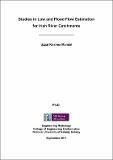| dc.description.abstract | This study focused on the estimation of low flows for Irish River catchments, particularly for ungauged catchments and on the estimation of flood flows in the context of changing climatic conditions, which is believed may be causing non-stationarity in the streamflow time series. The main objectives of the study were to develop a methodology to estimate low-flows for ungauged river catchments in Ireland, to investigate any evidence of the presence of trends in the Annual Maximum Flood (AMF) records and to investigate the effects of trends / non-stationarity on the design floods (on both growth curve and at-site quantiles) estimated from the conventional statistical frequency analysis techniques applied on a regional scale level. The study was carried out in two parts: (i) Part A deals with low-flows estimates, while (ii) Part B deals with the flood flow estimates in the presence of trends.
In the low-flow studies for Ireland, it was found that a regression-based 1-parameter logarithmic type model provides a good approximation to the lower three-quarter part of the Period-of-Record (POR) daily Flow Duration Curves (FDC) at most of the 125 gauging sites in Ireland. Given the complex shape of the observed FDCs and the higher variability in the high-flow sections of the FDCs, this study focused on modelling of only the lower three-quarter section of FDC (25%ile to 99.99%ile).The parameter of the proposed model has been estimated from the easily measurable/obtainable catchment physiographic and climatological characteristics, such as catchment areas (AREA), mean annual rainfall (SAAR) and mean annual potential evapotranspiration (PE). A sensitivity analysis on the mean daily flow records for 10 Irish River catchments showed that at least 15 to 20 years of observed streamflow records are required to obtain a reliable long-term POR equivalent estimate of the FDCs and associated low-flow indices. The study also showed that the Q95 flow estimate from 10 years of records at a site in the study region could deviate (under- or over-estimation) by approximately 20% from the equivalent long-term estimate.
In the search for any evidence of the presence of non-stationarity in Irish AMF records, a number of parametric and non-parametric tests were employed. The results showed that the Irish AMF series are in general dominated by positive serialcorrelations. Non-randomness properties were identified at 5% significance level in 17% of the sites, while 30% of sites showed step change in mean (mostly increase) during the post 1976 period. The trend test results identified considerably more trends in Irish AMF records than that would be expected to occur by chance. Significant trends were found at 30% of sites at 5% significance level, with increasing trends at 23% of sites. Some temporal variations in the trend test results are also apparent in the Irish AMF records. The Annual Maximum Rainfall (AMR) records of Ireland (1955-2008) also showed significant increasing trends, with longer rainfall durations showing greater tendency of trends. Some evidence of spatial patterns in trends in AMF and AMR series was detected by a mapping exercise which might indicate that the climate change may be responsible for AMF trends.
The findings of the simulation experiments carried out to identify the power of different trend identification tests (Mann-Kendall, Spearman¿s Rho and Standardised Linear Regression tests) showed that, in general, the power of a trend test is an increasing function of the trend slope and sample size, i.e. power increases with the increase in trend slope and sample size. This is true in all three tests. The simulation results also showed that the sample variance plays a very important role in detecting whether trend exists or not in the records.
The effects of trends on the regional growth curves and at-site quantiles were investigated through Monte Carlo Simulation techniques and in accordance with the Hosking and Wallis (1997) proposed L-moment algorithm procedures. Two different forms of trends were applied, one additive and the other hybrid, referred to as TF-1 and TF-2 respectively, in three different spatial patterns in the region / pooling group. The simulation results show that any trend causes changes in the population parameters, depending on the form and magnitude of trend and type of population distribution. TF-1 generally causes a flattening of growth curves, while TF-2 has the opposite effect. These changes can be as large as 16% at T=100 and trend slope of 1%. Trend effect on quantiles is generally positive, largely caused by an increase in the index flood, with increases up to 17% at T=100 and 1% trend slope. Some unrealistic results emerged in the GEV-GEV simulation case where large return period floods showed a decrease caused by the estimated GEV k value being (unexpectedly) positive when estimated from the data containing trends. | en_US |


